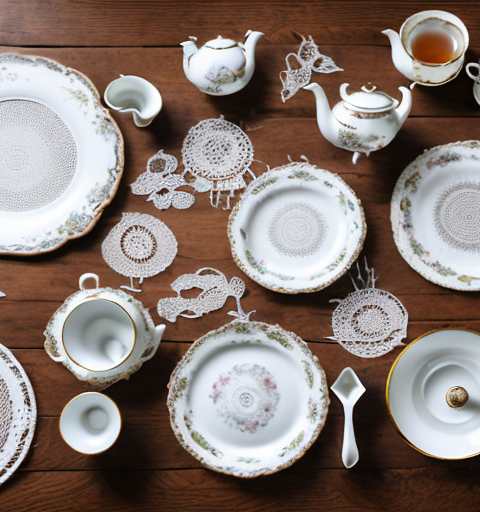Cleaning a ceramic teapot is an essential maintenance task that ensures its longevity and preserves the quality of your tea. Regular cleaning not only prevents the buildup of stains and residue but also helps maintain the natural flavors of your tea. In this article, we will explore the importance of cleaning a ceramic teapot, discuss the different types of ceramic teapots and their specific cleaning needs, provide a step-by-step guide to effectively clean your teapot, and offer expert tips and advice for avoiding common mistakes. Additionally, we will explore eco-friendly cleaning solutions for those who prefer natural alternatives, address stubborn stains and residue, discuss preventive measures to protect your teapot, and troubleshoot common cleaning issues.
Why cleaning a ceramic teapot is important for maintaining its quality
Ceramic teapots hold a special place in the hearts of tea enthusiasts. Not only do they add a touch of elegance to any tea ceremony, but they also allow for optimal heat retention, ensuring a perfect brew every time. However, without regular cleaning, the quality of your tea can be compromised. The accumulation of residue, oils, and stains can affect the taste and aroma of your tea, detracting from the overall experience. Cleaning your ceramic teapot regularly helps remove these impurities and ensures that your teapot continues to provide a delightful tea-drinking experience.
One of the main reasons why cleaning a ceramic teapot is important is to prevent the growth of bacteria and mold. Over time, if not properly cleaned, a teapot can become a breeding ground for harmful microorganisms. These can not only affect the taste and quality of your tea but also pose a health risk. Regular cleaning helps eliminate any potential contaminants and ensures that your teapot remains safe to use.
In addition to maintaining the quality of your tea, cleaning a ceramic teapot also helps prolong its lifespan. The buildup of residue and stains can gradually weaken the structure of the teapot, leading to cracks or breakages. By regularly cleaning your teapot, you can prevent the accumulation of these substances and ensure that your teapot remains in good condition for years to come.
Understanding the different types of ceramic teapots and their cleaning needs
Ceramic teapots come in a variety of forms, each with its own unique characteristics and cleaning requirements. It’s important to understand the type of ceramic used and any special instructions provided by the manufacturer. Some common types of ceramic teapots include porcelain, stoneware, and earthenware. Porcelain teapots are delicate and require gentle cleaning, while stoneware and earthenware teapots are more durable and can withstand slightly more aggressive cleaning techniques. It is essential to handle each type of ceramic teapot with care and follow the appropriate cleaning method to avoid damage.
In addition to porcelain, stoneware, and earthenware, there are other types of ceramic teapots that are worth mentioning. One such type is bone china, which is known for its translucent appearance and delicate nature. Bone china teapots should be handled with extreme care and cleaned using gentle methods to prevent any damage. Another type is terracotta, which is made from clay and has a rustic, earthy look. Terracotta teapots should be cleaned using mild soap and water, as harsh chemicals can cause the clay to deteriorate over time. Lastly, there are also modern ceramic teapots that are made using advanced techniques and materials, such as high-fired porcelain or ceramic blends. These teapots often have specific cleaning instructions provided by the manufacturer and should be cleaned accordingly to maintain their quality and longevity.
Step-by-step guide to cleaning a ceramic teapot effectively
Cleaning a ceramic teapot can be a straightforward process if you follow the correct steps. Here is a step-by-step guide to ensure effective cleaning:
- Begin by emptying the remaining tea or infusion from the teapot and rinsing it with warm water.
- Gently scrub the interior and exterior of the teapot using a soft sponge or brush. Avoid using abrasive materials that can scratch the ceramic surface.
- For stubborn stains or residue, create a paste using baking soda and water. Apply the paste to the affected areas and let it sit for a few minutes before gently scrubbing.
- Rinse the teapot thoroughly to remove any traces of cleaning agents.
- Dry the teapot with a soft, lint-free cloth, ensuring that no moisture remains, as this can lead to mold or mildew growth.
It is important to note that different types of ceramic teapots may require specific cleaning methods. For example, teapots with delicate or hand-painted designs may require extra care to avoid damaging the artwork. In such cases, it is recommended to consult the manufacturer’s instructions or seek professional advice.
Additionally, regular maintenance can help prolong the lifespan of your ceramic teapot. After each use, it is advisable to rinse the teapot with warm water and allow it to air dry before storing it. This helps prevent the buildup of tea stains and residue, making the cleaning process easier and more effective in the long run.
Essential tools and materials needed for cleaning a ceramic teapot
To effectively clean your ceramic teapot, you will need a few essential tools and materials:
- A soft sponge or brush: These are gentle enough to prevent scratching the ceramic surface.
- Baking soda: This multipurpose household ingredient helps remove stains and residue effectively.
- Vinegar: A natural cleaning agent that can be used to remove mineral deposits.
- Warm water: This is the ideal temperature for cleaning a ceramic teapot, as it helps dissolve stains and residue.
- A soft, lint-free cloth: This is used to dry your teapot thoroughly.
In addition to the tools and materials mentioned above, there are a few other items that can be helpful for cleaning a ceramic teapot:
- Q-tips or cotton swabs: These can be used to clean hard-to-reach areas, such as the spout or handle.
- White vinegar: If your teapot has stubborn stains or mineral deposits, soaking it in a mixture of white vinegar and water can help loosen and remove them.
It’s important to note that when cleaning a ceramic teapot, you should avoid using abrasive cleaners or scrub brushes, as these can damage the surface. Instead, opt for gentle cleaning methods and materials to ensure the longevity of your teapot.
Common mistakes to avoid when cleaning a ceramic teapot
Although cleaning a ceramic teapot might seem straightforward, it’s important to avoid common mistakes that can damage your teapot or affect the quality of your tea. Here are some mistakes to watch out for:
- Using harsh cleaning agents: Avoid using abrasive cleaners, bleach, or other harsh chemicals that can erode the ceramic surface.
- Scrubbing vigorously: Applying excessive force when scrubbing can scratch or chip the teapot. Always use gentle motions.
- Not drying thoroughly: Moisture left in the teapot can lead to the growth of mold or mildew. Be sure to dry the teapot completely.
- Subjecting the teapot to extreme temperatures: Rapid changes in temperature can cause the teapot to crack. Avoid pouring hot water into a cold teapot or vice versa.
Additionally, it is important to avoid using metal utensils when cleaning a ceramic teapot. Metal utensils can scratch the surface of the teapot, leading to potential damage. Instead, opt for soft brushes or sponges specifically designed for cleaning delicate ceramics.
Natural and eco-friendly cleaning solutions for your ceramic teapot
If you prefer to use natural and eco-friendly cleaning solutions, there are several effective options available:
- Lemon juice: The acidic properties of lemon juice help remove stains and residue. Simply apply lemon juice to a soft cloth and gently scrub the teapot.
- White vinegar: Diluted vinegar can effectively remove mineral deposits and stains. Mix equal parts vinegar and water, and use a soft cloth or sponge to clean the teapot.
- Baking soda: As mentioned earlier, baking soda is a versatile cleaning agent that can be used to create a paste to tackle stubborn stains and residue.
Another natural cleaning solution for your ceramic teapot is hydrogen peroxide. Hydrogen peroxide is a mild bleaching agent that can help remove tough stains and discoloration. To use hydrogen peroxide, dilute it with water and apply it to a soft cloth or sponge. Gently scrub the teapot and rinse thoroughly.
If you’re looking for a fragrant and effective cleaning solution, consider using tea tree oil. Tea tree oil has natural antibacterial properties and can help remove dirt and grime from your teapot. Mix a few drops of tea tree oil with water and apply it to a cloth or sponge. Wipe the teapot clean and rinse well to remove any residue.
Removing stubborn stains and residue from a ceramic teapot
Stubborn stains and residue can be a challenge to remove, but with the right techniques, you can restore your ceramic teapot to its original state. If regular cleaning methods do not suffice, consider the following options:
- Soaking with vinegar: Fill the teapot with a mixture of equal parts white vinegar and warm water. Allow it to soak overnight, and then scrub gently to remove the stubborn stains or residue.
- Boiling with baking soda: Fill the teapot with water, add a tablespoon of baking soda, and bring it to a boil. Let it simmer for a few minutes before emptying the teapot and scrubbing away any remaining stains or residue.
- Using a non-abrasive cleaning solution: Purchase a non-abrasive ceramic cleaner specifically designed for teapots. Follow the instructions provided by the manufacturer.
Another option for removing stubborn stains and residue from a ceramic teapot is to use a paste made from baking soda and water. Mix equal parts baking soda and water to create a thick paste. Apply the paste to the stained areas of the teapot and let it sit for about 30 minutes. Then, scrub the teapot gently with a soft sponge or brush to remove the stains. Rinse the teapot thoroughly with water to remove any residue from the baking soda paste.
If the stains or residue on your ceramic teapot are particularly stubborn, you can try using a mixture of lemon juice and salt. Sprinkle salt onto the stained areas of the teapot, and then squeeze fresh lemon juice over the salt. Let the mixture sit for a few minutes, and then scrub the teapot gently with a sponge or brush. The acidity of the lemon juice combined with the abrasive texture of the salt can help to break down and remove tough stains and residue. Rinse the teapot well with water after scrubbing to remove any remaining lemon juice or salt.
Tips for preventing discoloration and damage while cleaning a ceramic teapot
Prevention is key when it comes to maintaining the appearance and quality of your ceramic teapot. Follow these tips to avoid discoloration and damage:
- Avoid using metal utensils: Metal utensils can scratch the ceramic surface. Opt for wooden or silicone utensils instead.
- Store the teapot properly: When not in use, store your teapot in a cool and dry place, away from direct sunlight. Excessive heat or light can cause discoloration.
- Avoid prolonged contact with water: After use, promptly empty any remaining liquid from the teapot to avoid prolonged exposure to moisture.
How frequently should you clean your ceramic teapot?
The frequency of cleaning your ceramic teapot depends on several factors, including how frequently you use it and the type of tea you brew. As a general rule, it is recommended to clean your teapot after each use. Routine cleaning prevents the buildup of stains and residue, ensuring that the flavors of your tea remain uncompromised. If your teapot is used infrequently, a monthly deep-cleaning routine should suffice.
Deep-cleaning techniques for heavily soiled or neglected ceramic teapots
If your ceramic teapot has been neglected or heavily soiled over time, a deep-cleaning routine can help restore its original condition. Here’s how to deep-clean your teapot:
- Prepare a solution using warm water and a few drops of mild dish soap.
- Fill the teapot with the solution and let it soak for a few hours, or overnight for stubborn stains and residue.
- Gently scrub the teapot using a soft sponge or brush, paying extra attention to the affected areas.
- Thoroughly rinse the teapot to remove any soap residue.
- Dry the teapot with a soft cloth, ensuring complete moisture removal.
The role of temperature in cleaning a ceramic teapot safely
Temperature plays a crucial role in safely cleaning a ceramic teapot. Extreme temperature changes can cause the teapot to crack or shatter. Always ensure that the teapot is at room temperature before cleaning. Avoid pouring boiling water into a cold teapot or placing a hot teapot on a cold surface. Gradual temperature changes and gentle cleaning methods will help preserve the integrity of your teapot.
Cleaning the exterior of your ceramic teapot: Dos and Don’ts
While the interior of your ceramic teapot requires regular cleaning to maintain the quality of your tea, the exterior also requires attention. Here are some dos and don’ts when cleaning the exterior:
- Do: Wipe the exterior of the teapot with a damp cloth or sponge to remove any dust or residue.
- Do: If the exterior becomes heavily soiled, use a mild dish soap and warm water solution to clean it gently.
- Don’t: Immerse the entire teapot, including the lid, in water. Excessive moisture can damage the structural integrity of the teapot.
- Don’t: Use abrasive materials or harsh chemicals on the exterior, as this can damage the surface and affect the appearance of the teapot.
Expert advice on maintaining the longevity of your ceramic teapot through proper cleaning practices
To further enhance the longevity of your ceramic teapot, our experts recommend the following tips:
- Handle with care: Treat your teapot with gentleness and avoid rough handling or accidental impacts that can cause chips or cracks.
- Regularly replace filters: If your teapot has a built-in filter or infuser, ensure it is cleaned or replaced regularly to prevent tea particles from accumulating and affecting the taste of your tea.
- Avoid dishwasher use: While some teapots claim to be dishwasher-safe, it is best to hand-wash your ceramic teapot to prevent potential damage from harsh dishwasher detergents or aggressive water pressure.
- Periodically inspect for cracks: Inspect your teapot for cracks or damage. If you notice any, discontinue use immediately to prevent further issues.
Troubleshooting common issues encountered when cleaning a ceramic teapot
Even with careful cleaning practices, you may encounter some common issues. Here are some troubleshooting tips:
- Stuck-on residue: If residue remains after cleaning, create a paste using baking soda and water, and gently scrub the affected areas before rinsing.
- Mineral deposits: Soak the teapot in a solution of equal parts white vinegar and water overnight, then gently scrub to remove the deposits.
- Mold or mildew: If mold or mildew develops, use a solution of white vinegar and water to disinfect the teapot. Rinse thoroughly and dry completely.
By following these comprehensive cleaning practices, you can ensure that your ceramic teapot remains in excellent condition, providing you with countless enjoyable tea experiences. Remember, a clean teapot not only enhances the taste of your tea but also reflects your appreciation for the art of tea brewing.






